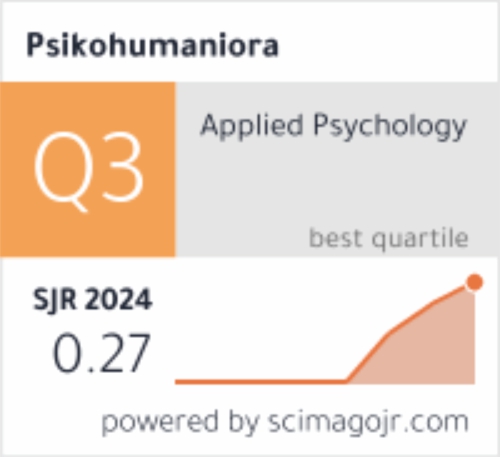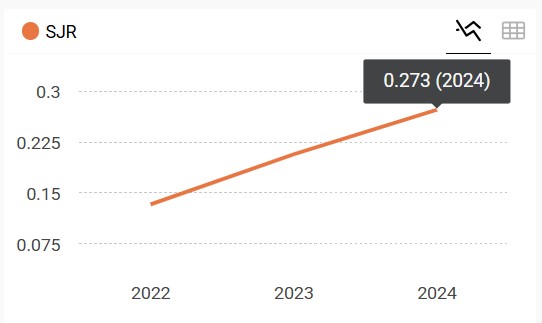Trauma-Focused Cognitive Behavioral Therapy to reduce symptoms of post-traumatic stress disorder in adolescent victims of incest
DOI:
https://doi.org/10.21580/pjpp.v6i2.8242Keywords:
incest, post-traumatic stress disorder, sexual violence, trauma-focused cognitive behavioral therapyAbstract
The threat of sexual violence can occur anywhere, including in the family environment. The subject of this study was a fifteen-year-old girl with a diagnosis of post-traumatic stress disorder who had been a victim of incest by her stepfather. The study aims to examine the effectiveness of trauma-focused cognitive behavioral therapy to reduce symptoms of post-traumatic stress disorder. It uses a Single Case-Single Subject ABA design. The intervention involved 12 sessions of trauma-focused cognitive-behavioral therapy. Symptoms of posttraumatic stress disorder were measured by the Child Posttraumatic Stress Disorder Symptom Scale (CPSS). There was a change in the CPSS scores in the intervention and post-intervention processes, with the post-traumatic stress disorder scores changing from the moderate to the mild category of post-traumatic stress disorder. The decrease in the scores was also evidenced by the results of the different pre-intervention, intervention, and post-intervention CPSS scores using Mann-Whitney nonparametric analysis. The study has implications for the application of trauma-focused cognitive-behavioral therapy to reduce symptoms of post-traumatic stress disorder in adolescent girls who are victims of incest.
Downloads
References
American Psychiatric Association. (2013). Diagnostic and statistical manual of mental disorder: DSM-5 (5th ed.). American Psychiatric Association.
Benjamin, S., & Sadock, V. A. (2012). Buku ajar psikiatri klinis. Penerbit Buku Kedokteran EGC.
Cary, C. E., & McMillen, J. C. (2012). The data behind the dissemination: A systematic review of Trauma-Focused Cognitive Behavioral Therapy for use with children and youth. Children and Youth Services Review, 34(4), 748–757. https://doi.org/10.1016/j.childyouth.2012.01.003
Chaplin, J. P. (2006). Kamus lengkap psikologi (K. Kartini (ed.)). Raja Grafindo Persada.
Cohen, J. A., Mannarino, A. P., Berliner, L., & Deblinger, E. (2000). Trauma-Focused Cognitive Behavioral Therapy for children and adolescents: An empirical update. Journal of Interpersonal Violence, 15(11), 1202–1223. https://doi.org/10.1177/088626000015011007
DP3A Kota Semarang. (2020). Data kekerasan terhadap perempuan & anak. http://kekerasan.dp3a.semarangkota.go.id/
Foa, E. B., Asnaani, A., Zang, Y., Capaldi, S., & Yeh, R. (2017). Psychometrics of the Child PTSD Symptom Scale for DSM-5 for trauma-exposed children and adolescents. Journal of Clinical Child & Adolescent Psychology, 47(1), 38–46. https://doi.org/10.1080/15374416.2017.1350962
Foa, E. B., Johnson, K. M., Feeny, N. C., & Treadwell, K. R. H. (2001). The child PTSD symptom scale: A preliminary examination of its psychometric properties. Journal of Clinical Child & Adolescent Psychology, 30(3), 376–384. https://doi.org/10.1207/S15374424JCCP3003_9
Fu’ady, M. A. (2011). Dinamika psikologis kekerasan seksual: Sebuah studi fenomenologi. Psikoislamika: Jurnal Psikologi Dan Psikologi Islam, 8(2), 191–208. https://doi.org/10.18860/psi.v0i0.1553
Furlong, N. E., Lovelace, E. A., & Lovelace, K. L. (2000). Research methods and statistics an integrated approach (Vol. 2). Horcourt College Pub.
Goldbeck, L., Muche, R., Sachser, C., Tutus, D., & Rosner, R. (2016). Effectiveness of Trauma-Focused Cognitive Behavioral Therapy for children and adolescents: A randomized controlled trial in eight German Mental Health Clinics. Psychotherapy and Psychosomatics, 85(3), 159–170. https://doi.org/10.1159/000442824
Hendricks, A., Kliethermes, M., Cohen, J. A., Mannarino, A. P., & Deblinger, E. (n.d.). Dealing with trauma: A TF-CBT workbook for teens. Trauma-Focused Cognitive Behavioral Therapy - National Therapist Certification Program. https://tfcbt.org/dealing-trauma-workbook-teens/
Kartini, K. (2009). Psikologi abnormal dan abnormalitas seksual. Mandar Maju.
Kiswanto, A. (2017). From helplessness to optimism: Using Trauma Focused-Cognitive Behavioral Therapy (TF-CBT). International Conference on Indonesian Islam, Education and Science.
Komisi Nasional Anti Kekerasan terhadap Perempuan. (n.d.). Menemukenali Kekerasan dalam Rumah Tangga (KDRT).
KPAI. (2017a). Data kasus perlindungan anak berdasarkan lokasi pengaduan dan pemantauan media se-Indonesia tahun 2011-2016| Bank Data Perlindungan Anak. Bank Data KPAI 2011-2016. Bankdata.Kpai.Go.Id. https://bankdata.kpai.go.id/tabulasi-data/data-kasus-se-indonesia/data-kasus-perlindungan-anak-berdasarkan-lokasi-pengaduan-dan-pemantauan-media-se-indonesia-tahun-2011-2016
KPAI. (2017b). Rincian data kasus berdasarkan klaster perlindungan anak, 2011-2016 | Bank Data Perlindungan Anak. Data kasus kekerasan seksual terhadap anak Komisi Perlindungan Anak Indonesia. Bankdata.Kpai.Go.Id.
Learning from Research and Clinical Practice Core and Child Sexual Abuse Task Force. (2004). How to implement trauma-focused cognitive behavioral therapy. National Center for Child Traumatic Stress.
Lewey, J. H., Smith, C. L., Burcham, B., Saunders, N. L., Elfallal, D., & O’Toole, S. K. (2018). Comparing the effectiveness of EMDR and TF-CBT for children and adolescents: a Meta-analysis. Journal of Child & Adolescent Trauma, 11(4), 457–472. https://doi.org/10.1007/s40653-018-0212-1
McNew, J. A., & Abell, N. (1995). Posttraumatic stress symptomatology: Similarities and differences between Vietnam veterans and adult survivors of childhood sexual abuse. Social Work, 40(1), 115–126.
Nevid, J. S., Rathus, S. A., & Greene, B. (2018). Psikologi abnormal di dunia yang terus berubah (K. Yuniarti, O. M. Dwiasri, & A. Maulana (eds.)). Erlangga.
Noviana, I. (2015). Kekerasan seksual terhadap anak: Dampak dan penanganannya. Sosio Informa, 1(1). https://doi.org/10.33007/INF.V1I1.87
Powell, B. J., Patel, S. V., Haley, A. D., Haines, E. R., Knocke, K. E., Chandler, S., Katz, C. C., Seifert, H. P., Ake, G., Amaya-Jackson, L., & Aarons, G. A. (2019). Determinants of implementing evidence-based trauma-focused interventions for children and youth: A systematic review. Administration and Policy in Mental Health and Mental Health Services Research, 47(5), 705–719. https://doi.org/10.1007/S10488-019-01003-3
SIMFONI-PPA. (2021). Peta sebaran jumlah kasus kekerasan menurut provinsi, tahun 2021. Sistem Informasi Online Perlindungan Perempuan dan Anak. https://kekerasan.kemenpppa.go.id/ringkasan
Sunanto, J., Takeuchi, K., & Nakata, H. (2005). Pengantar penelitian dengan subjek tunggal. Center for Research on International Cooperation in Educational Development (CRICED) University of Tsukuba.
Suyanto, B. (2019, July 24). Orangtua, pelindung atau ancaman bagi anak. Media Indonesia. https://mediaindonesia.com/opini/248763/orangtua-pelindung-atau-ancaman-bagi-anak
Tursilarini, T. Y. (2017). Dampak kekerasan seksual di ranah domestik terhadap keberlangsungan hidup anak. Media Informasi Penelitian Kesejahteraan Sosial, 41(1), 77–92. https://doi.org/10.31105/mipks.v41i1.2277
Downloads
Published
How to Cite
Issue
Section
License
The copyright of the accepted article shall be assigned to the publisher of the journal. The intended copyright includes the right to publish the article in various forms (including reprints). The journal maintains the publishing rights to published articles.
In line with the license, authors and any users (readers and other researchers) are allowed to share and adapt the material only for non-commercial purposes. In addition, the material must be given appropriate credit, provided with a link to the license, and indicated if changes were made. If authors remix, transform, or build upon the material, authors must distribute their contributions under the same license as the original.



